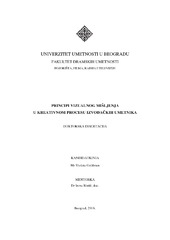Принципи визуалног мишљења у креативном процесу извођачких уметника
doktorska disertacija
Metapodaci
Prikaz svih podataka o zapisuDoktorand:
Violeta GoldmanFakultet:
Факултет драмских уметностиDatum odbrane:
17-05-2016Mentor:
Ristić, dr IrenaČlanovi komisije:
- Rapajić, Svetozar
- Vuksanović, dr Divna
- Medenica, dr Ivan
- Škorc, dr Bojana
Sažetak
Sve ključne teorije, metode i tehnike glume, od Stanislavskog do danas,
zasnivaju se na pretpostavci da je u kreativnom procesu glumaca veoma važan rad sa
čulima, a posebno rad na glumačkim mogućnostima vizualizacije. U ovom radu
ispituje se na kojim operativnim principima se zasniva vizualno mišljenje i
vizualizacija, i kako ti različiti principi utiču na glumačku kreativnost, uz oslanjanje
na uvide o fundamentalnim procesima kreativne kognicije. U fokusu je proces
nastajanja uloga kod glumaca koji stvaraju mimetičko pozorište, zasnovano na
interpretaciji dramskog teksta.
Teorijska analiza je utemeljena u komparaciji različitih filozofskih koncepcija
imaginacije i vizualizacije, uz poseban osvrt na uvide Dejvida Hjuma, Imanuela
Kanta i Johana Gotliba Fihtea. Razmotreni su rezultati savremenih psiholoških
istraživanja kreativne kognicije, kao i uvidi pozorišnih teoretičara i pedagoga o
primeni vizualizacije u radu sa glumcima, posebno Stanislavskog, Li Strazberga i
Mihaila... Čehova. Analizom karakteristika i funkcija mentalnih slika, naročito u
okviru imaginativnih procesa ispitane su mogućnosti njihove primene u glumačkom
pripremnom radu, kao i tokom izvođenja. Razmotrene su različite funkcije
imaginacije i vizualizacije, u svetlu evolucione i mimetičke teorije, kao i teorije
blendinga, a posebna pažnja je posvećena teorijama projekcije. Sledstveno u radu je
provereno da li uvidi o funkcionisanju vizualnog mišljenja tokom kreativnog procesa
glumaca mogu biti primenjeni u koncipiranju novih pristupa usmerenih na razvoj
glumačkog izraza.
U empirijskom delu istraživanja provereno je kako tehnika zasnovana na
vizualizaciji utiče na kreativni proces glumca i može li menjati kvalitet izvođenja.
Mada se rezultati kvantitativnog i kvalitativnog istraživanja delimično razlikuju,
ukrštanje teorijskih uvida sa ishodima eksperimenta pruža punu potvrdu vizualnom
modelu mogućnosti koji uključuje prekognitivne, kognitivne i metakognitivne aspekte
imaginacije, i obezbeđuje potpunu apsorpciju glumca u imaginarne okolnosti komada.
Predloženi vizualni model koji glumcu omogućuje da pomoću vizualizacije otkrije i
ispita različite imaginarne okolnosti može biti temelj za razradu novih izvođačkih
tehnika i metoda, kako u pozorištu baziranom na dramskom tekstu u konceptu
predstave, tako i u drugim modalitetima.
All key theories, methods and techniques of acting, from Stanislavski to date,
are based on the assumption that the work with senses, especially the work on the
acting possibilities of visualization, is very important in the creative process of the
actors. This paper examines the operating principles on which the visual thinking and
visualization are based, and how those different principles affect the acting creativity,
relying on the insights about the fundamental processes of creative cognition. The
focus is on the process of the formation of the roles of the actors who work with
conceptualized dramatic text, following the methods of mimetic theatrical frame.
Theoretical analysis is based on the comparison of various philosophical
concepts of imagination and visualization, with special reference to the insights of
David Hume, Immanuel Kant and Johann Gottlieb Fichte. The results of modern
psychological research of creative cognition are discussed, as well as the insights ...of
theater theorists and pedagogues on the application of visualization in the work with
the actors, especially Stanislavski, Lee Strasberg and Michael Chekhov. By analyzing
the characteristics and function of mental images, especially in the context of the
imaginative processes, the possibilities of their application are examined in the acting
work and during performance. Various functions of imagination and visualization are
further discussed, in the light of the evolutionary and mimetic theory, as well as the
theory of blending, and special attention is paid to the theories of projection.
Consequently, the paper verifies if the insights about the functioning of visual
thinking during the creative process of the actors can be applied in the design of new
approaches aimed at the development of acting expression.
In the empirical part of the research, it is verified how the technique based on
visualization affects the creative process of the actor and whether it can change the
quality of the performance. Although the results of quantitative and qualitative
research differ in part, the intersection of theoretical insights with the outcomes of the
experiment gives a complete confirmation to the visual model of possibilities which
includes precognitive, cognitive and metacognitive aspects of imagination, and
provides complete absorption of the actor into the imaginary circumstances of the
play. The proposed visual model that allows the actor to discover and explore various
imaginary circumstances using visualization, could be the basis for the development
of new performing techniques and methods, both in the theater based on the dramatic
text in the concept of the play, as well as in other modalities

